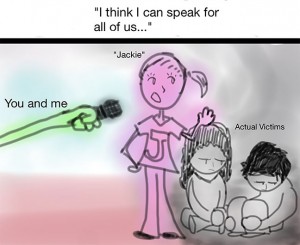From the moment they start writing, journalists are taught to always fact check their sources.
If it can’t be proved, don’t publish it. It’s better not to include something rather than for it to come out as a lie in the end.
So, what happens when a publication releases a story with facts that haven’t been proved, haven’t been checked and ultimately come out as false?
In November, Rolling Stone published a story titled “A Rape on Campus” focused around a University of Virginia student by the given name of “Jackie” and her account of allegedly being gang-raped while at a campus frat party. The story quickly went viral in just a few days, but within those few days, questions began to arise over the factual evidence presented in the article.

As more questions arose, more discrepancies were found, and before anyone knew it, Rolling Stone had a full-fledged controversy on its hands and no shred of evidence to prove otherwise.
With the situation escalating, Rolling Stone retracted the article and partnered with Columbia University’s School of Journalism to try to figure out what exactly went wrong in the story’s process. In the report released by the school this month, the problem was that the reporter relied on one source for her entire story.
One source provided the information. One source provided the quotes, the facts, the evidence. One source that no one ever fact-checked. Every person involved with the story, from the writer to managing editor, had the opportunity to verify and question the facts. But not once did anyone do that.
By not pushing for concrete answers, Rolling Stone failed to exhibit Reporting 101. The magazine put negative attention on an organization that arguably didn’t do anything wrong. It not only made the university, its faculty and its students look bad, the article also reflected poorly on the publication itself.
When a publication fails to prove a story before it is released, it not only discredits itself as a reliable source, it discredits journalism as a whole. With hot-topic items such as rape already being hard enough to cover in the media, Rolling Stone just made it even harder for real victims to open up, for real truth to come out, lest people assume it is all a lie too.
One source cannot be the sole provider for an article’s existence.
When a source gives information, particularly controversial information, but refuses to allow the writer to reach out to verify what is given, that source shouldn’t be used. Sources are supposed to give credibility and proof to an article.
The writer of the article, Sabrina Rubin Erdely, admitted that Jackie had proved difficult throughout the reporting process. When a source is repeatedly difficult, that source shouldn’t be used.
Erdely had plenty of opportunities to change direction with the story, use another source or just drop Jackie altogether, but she chose not to. By doing this, she cost her publication its reputation as a news source as well as her as a writer.
If a source lies, it falls on the publication to make sure every fact has been checked to ensure honesty and trust between the publication and its readers. By failing to ensure this, Rolling Stone has effectively discounted itself as a reliable source for major issue stories.
If a publication cannot write a story on such a major issue without it falling apart, maybe that publication shouldn’t be writing that kind of story at all.
